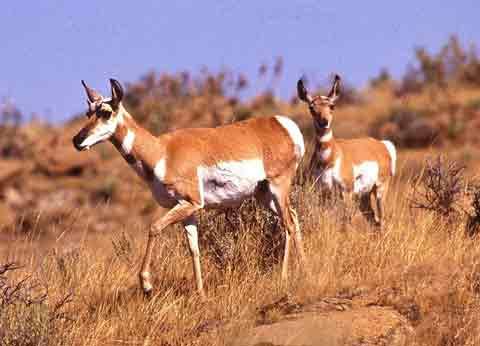Pronghorn antelope can run up to 60 miles per hour, making them second only to cheetahs in speed for land animals. Lewis and Clark dubbed the animals “speed goats,” but now scientists have confirmed that pronghorn are both sprinters and marathoners.
Researchers from the Wildlife Conservation Society (WCS) and the Idaho-based Lava Lake Institute for Science and Conservation have discovered an overland migration route of pronghorn antelope that "ranks among the farthest for any land mammal in the Western Hemisphere." Part of the route passes through Craters of the Moon National Monument and Preserve in Idaho, and the park is making changes in some fences to aid in the animals' twice a year trek.
The migration route stretches from the base of Idaho’s Pioneers Mountains to the Beaverhead Mountains, a round trip in excess of 160 miles.
“This study shows that pronghorn are the true marathoners of the American West,” said Scott Bergen, project director for WCS. “With these new findings, we can confirm that Idaho supports a major overland mammal migration—something that is becoming increasingly rare in the U.S. and worldwide.”
Researchers estimate 100 to 200 pronghorn currently use the migration route. During the winter, the antelope congregate with other regional herds from the area, making the pronghorn herd of about a thousand animals the largest in Idaho.
Wildlife managers and organizations are working to ensure the migration route continues to be available to the animals, but there are plenty of challenges.
The authors of the study warn that the route is threatened by increased habitat fragmentation from development and other land-use changes. Growing interest in development of large-scale wind farms and their associated power-lines could threaten the migration route.
“As the American West continues to face increased development pressure, preserving migratory corridors will become more and more crucial to safeguarding large populations of wildlife like pronghorn,” said Dr. Jodi Hilty, Director of North America Programs for the Wildlife Conservation Society, and author of the book Corridor Ecology.
“We have lost so many migrations globally, that these sorts of finds should inspire more of us to help give this uniquely American species a chance to roam in Idaho and throughout its range.”
The migration route that crosses part of the park includes plenty of challenges for the animals. The WCS study notes the route
crosses federal, state, and private land and narrows in one stretch to a bottleneck less than two football fields wide. There, animals are restricted by mountains, fences, a highway, and fields of jagged lava...
Some of those fences were constructed many years ago at Craters of the Moon National Monument and Preserve in an effort to solve a decades-long problem with livestock trespass into the park. While the fencing helped control wandering cattle and sheep, it also created unexpected problems for the pronghorn.
Steven Bekedam, the Vegetation Ecologist at the park, says information from the study is being used to as a guide to removing or modifying fences that could interfere with the migration. During the past year, the NPS removed a half-mile of old livestock fence, and the park is now planning to modify some other fences that are constructed of wire mesh.
Fences can be a major deterrent to pronghorn travel. The animals will rarely attempt to jump fences, but they will go under one that provides sufficient space (about 16 to 18 inches) between the bottom wire and the ground. If you're a landowner or just interested in fencing that considers wildlife needs, this publication from the Colorado Division of Wildlife has more details.
Several groups are hard at work to protect the overall migration route.
WCS is working with ranchers, conservationists, and public lands managers to safeguard the large family ranches that have helped support this migration route over the past 100 years. The Pioneers Alliance, a coalition of landowners, ranchers, conservationists, and state and federal land managers, is working to develop conservation easements and other mechanisms to protect working ranches and farms that are part of the pronghorn migration route.
“We are committed to working with many partners, including private landowners and state and federal land managers to take the steps needed to sustain this long distance migration,” said Tess O’Sullivan, Program Director for the Lava Lake Institute.
Recently the Governors of Idaho and Montana signed agreements with the Departments of Interior, Agriculture, and Energy to improve management on federal lands where pronghorn migrate. In addition, Congress has recognized the value of wildlife migrations corridors as a strategy for adapting to global warming in pending climate change legislation.
Steps have already been taken to protect a second migration route for pronghorn in the West.
In 2005, Wildlife Conservation Society scientists used GPS collars to document another migratory herd of pronghorn in Wyoming that travel from Grand Teton National Park to the Green River Valley. With the leadership of the U.S. Forest Service, the nation’s first designated wildlife migration corridor to protect 150-mile round-trip movement of pronghorn in the Greater Yellowstone Ecosystem was created. It has since been safeguarded in a unique public/private partnership called “Path of the Pronghorn.”
These projects are good examples of ways cooperative efforts between parks, other agencies and private organizations can result in positive steps for wildlife conservation. Kudos to the staff at Craters of the Moon, the Wildlife Conservation Society, the Lava Lake Institute, and other organizations for their work on this project.


 Support Essential Coverage of Essential Places
Support Essential Coverage of Essential Places







Add comment